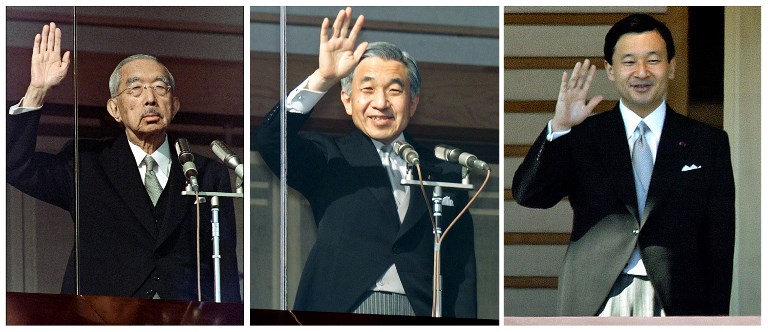
Japan’s Emperor Akihito will step down on April 30, 2019, the prime minister announced on December 1, 2017, the first retirement in more than two centuries in the world’s oldest imperial family. / AFP PHOTO / KAZUHIRO NOGI
by Richard Carter
Agence France Presse
TOKYO, Japan (AFP) — Japan’s Emperor Akihito will step down on April 30, 2019, the prime minister announced Friday, the first retirement in more than two centuries in the world’s oldest imperial family.
Shinzo Abe said he was “deeply moved” at the “smooth decision” taken at a special meeting of the Imperial Council to decide on the date for the popular 83-year-old to step down for health reasons.
“The government will make utmost efforts to ensure that the Japanese people can celebrate the emperor’s abdication and the succession of the crown prince,” added Abe.
Akihito’s eldest son, 57-year-old Crown Prince Naruhito, is expected to ascend the Chrysanthemum Throne the next day.
The news was splashed across the front pages of the evening papers, with the Sankei Shimbun distributing a special abdication edition.
The abdication will bring to an end the current Heisei era which has lasted the 30 years Akihito has been on the throne.
The emperor shocked the country last year when he signalled his desire to take a back seat after nearly three decades, citing his age and health problems.
There have been abdications in Japan’s long imperial history dating back more than 2,600 years but the last one was more than two centuries ago.

Japan’s Emperor Akihito will step down on April 30, 2019, the prime minister announced on December 1, 2017, the first retirement in more than two centuries in the world’s oldest imperial family. Akihito’s eldest son, 57-year-old Crown Prince Naruhito, is expected to ascend the Chrysanthemum Throne on May 1, 2019. / AFP PHOTO / –
Akihito is the 125th person to sit on the Chrysanthemum Throne since Emperor Jimmu, said to be a descendant of the legendary sun goddess Amaterasu.
Emperors have played a crucial role in the country’s native Shinto religion, conducting various annual rites and prayers for the prosperity of the nation.
– Female succession –
There is no republican movement to speak of in Japan and the emperor and the royal family enjoy the admiration of the vast majority of the country.
The emperor and his wife Empress Michiko are seen as being the more accessible face of a monarchy that largely remains in the shadows, unlike the British royals.
But Akihito’s unexpected move presented a challenge since there was no law to deal with an emperor retiring from what is usually a job for life — and it reignited debate about allowing women to ascend the traditionally male-only throne.
In June, the parliament passed a one-off rule allowing the ageing emperor to step down.
The abdication must take place within three years and applies only to Akihito, who has been treated for prostrate cancer and has also had heart surgery.
Some worried that changing the rule to allow any emperor to abdicate could put Japan’s future monarchs at risk of political manipulation.
The status of the emperor is sensitive in Japan given its 20th century history of war waged in the name of Akihito’s father Hirohito, who died in 1989.
Akihito was born in 1933 just as Japan was embarking on its militaristic sweep across Asia, and was 11 when the war ended in defeat.
His father was allowed to remain on the throne after Japan’s defeat, but his status was downgraded from semi-divine sovereign to a figurehead with no political power.
Akihito embraced the role and tried to use it to help heal the scars of the war while remoulding one of the world’s oldest monarchies for a democratic age.
Even before he assumed the throne, Akihito broke with tradition when he married the daughter of a wealthy flour magnate in 1959, becoming the first imperial heir to wed a commoner.
Akihito is barred from commenting on politics, but he has over the years hinted at his own anti-nationalist views.
Speaking at a memorial marking the 70th anniversary of Japan’s surrender, Akihito expressed “deep remorse” for the country’s actions in World War II.
The looming abdication has reignited concerns about a potential succession crisis.
There are no more eligible male heirs after the 11-year-old son of Crown Prince Naruhito’s younger brother Akishino.
Japan’s centuries-old succession would be broken if that son, Hisahito, does not have a male child.
In response, Japan’s parliament has called for a debate on giving women a bigger role in the male-dominated monarchy.
The idea — including the possibility of letting women ascend the throne — is popular with ordinary Japanese, but it is vehemently opposed by traditionalists.
Female imperial family members lose their royal status upon marriage to a commoner, a point highlighted by the engagement of one of Akihito’s granddaughters, Princess Mako, to her college sweetheart.








